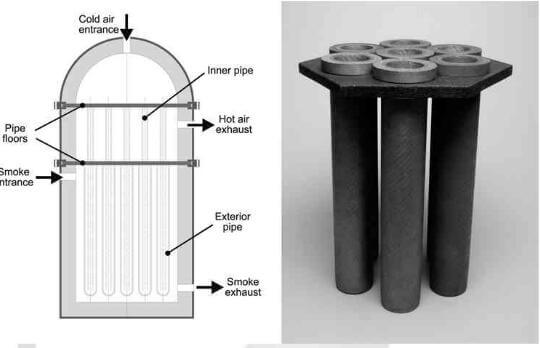Further fields of application: The economically most attractive field of application for C/SiC composites are primary structures in the energy industry. Despite their limitations of oxidation resistance, international research continues to improve manufacture processes and surface coatings for the long term use of C/SiC composites under corrosive conditions. One first step towards ceramic constructions in energy and power station engineering is the development of a double-pipe heat exchanger in bayonet-pipe technique, which is intended for use in combined processes with indrectly fired gas burbines using coal, Fig 8. Here the HT heat exchanger serves for the indirect firing of a gas turbine. The air to be heated flows through the coaxially arranged fibre ceramic pipes. In cross-contercurrent direction, the flue gas flows around the pipe rows, which are laid out in a staggered arrangement. The coated C/C-SiC pipes are mounted separately in corresponding pipe floors, thus reducing the tension stress induced by longitudinal expansions. Because of the micro-porosity of the C/C-SiC materials, the multi-layered coatings for corrosion protection have great significance for this application, since these protective coatings have two functions: to act as a sealing agent for the pressurized pipes, and also to protect the matrix and the carbon fibres from oxidation and corrosion.

fig.8-design principles and construction study of a HT-heat exchanger with CC-SiC tubes
Components in the furnace chamber of thermal incineration installations require an extreme mechanical, thermal and corrosive resistance, particularly if problematic waste is burned. Moving firing grates made of C/SiC with a high ceramic content, which simultaneously have a forward feed of the material to be burned are already in operation in incineration installations. These C/SiC components are designed as hollow bodies, so that additional air can be introduced via holes, thus achieving an optimization of the incineration.
In the field of furnace engineering, C/C-SiC ceramics are used as charging devices and work piece supports for metal hardening. These ceramic components considerably lighter in comparision with high-temperature resistant metals, and they have a very low tendency to warping and distortion at high temperatures. Charging devices can be produced from textile preforms that are contoured similar to the final product, so that only very little machining effort is necessary. Further industrial components manufactured in series are C/C-SiC fan blades used to circulate the atmosphere in heat treatment furnaces. Oxygne probe tubes, thermocouple protection tubes, pouring gutters used in metallurgy, or HT-nozzles made of C/C-SiC fibre ceramic are also practical operation and are here mostly replacing monolithic ceramic materials.
In the field of ballistic protection of vehicles and aircraft, the use of monolithic ceramics in compound systems permits a weight reduction of more than 50% as compared to armor plating steels. Further-reaching mass reductions are possible for future lightweight armor by using light C/SiC or C/C-SiC plates instead of the alumina or silicon carbide materials commonly used. Ballistic testes have shown, that fiber ceramics additionally offer improved protection against multiple hits because of their higher fracture toughness.
A typical lightweight armor principally consists of a multi-layered sandwich compound, of which the front side is made of a ceramic material and the rear side is primarily made of energy absorbing materials, such as synthetic fabrics or ductile metals. A side of the potentially lower weight per unit area of such lightweight armor, the variability in the design of the fiber ceramics is another essential advantage of fibre ceramics in comparison to conventional ceramics. Their manufacture is based on the classic methods used in composites technoloty, which allows volume of future fibre ceramic production, besides brake discs, is consequently envisaged in ballistic protectiion systems based on C/SiC and C/C-SiC composites.
To continue…
Related news /knowledge:
- Carbon fiber reinforced silicon carbide composites (C/SiC, C/C-SiC)-(3)-application
- Carbon fiber reinforced silicon carbide composites (C/SiC, C/C-SiC)-(4)-application
- Carbon fiber reinforced silicon carbide composites (C/SiC, C/C-SiC)-(6)-processing
- Carbon fiber reinforced silicon carbide composites (C/SiC, C/C-SiC)-(7)-processing